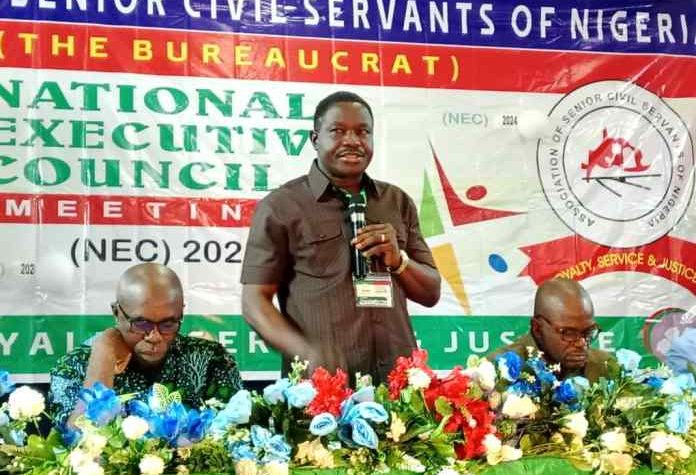
Posted by allcitynews.ng
No Nigerian can visit Ajaokuta Steel Company (ASC), see investments of more than $8 billion rotting in the African sun, and not cry.
I went there, I cried. What exactly is the problem? I have written several articles on this topic, but today, let me write a comprehensive post.
Ajaokuta Steel Company is massive; she has a 68km road network and 24 housing estates on the project. Some estates have over 1,000 homes, a seaport, and a 110mw power generation plant; there are 43 separate plants in Ajaokuta alone. It is estimated that if Ajaokuta becomes operational, it will create 500,000 jobs.
There is no industrialised nation on earth that does not have a steel sector. It’s that simple. A Central Bank of Nigeria (CBN) report shows that Nigeria currently imports steel, aluminium products, and associated derivatives of approximately 25 metric tonnes per annum, estimated at $4.5 billion.
This figure will continue to rise, and the Nigerian economy will continue to expand. Ajaokuta is an integrated steel company; it was designed by the Russians to be self-sufficient, get all its input from Nigeria, and make steel. Ajaokuta’s strength is its weakness; Ajaokuta can only work with all available inputs.
This will be a slightly technical post, but please try and follow.
Steel is an alloy of iron and carbon, amongst other things; iron is the base metal in steel, and to make steel, you need Iron Ore, Coke from Coal, and Limestone as the main components. These components are mixed in a blast furnace to produce liquid steel, which can be long steel for rail lines, flat steel for automobile making, etc.
For example, look at steel as making jollof rice, iron ore as the rice, limestone and coke as the pepper and salt, and the pot as the blast furnace.
The blast furnace is ONLY turned on at a steel plane when the company is ready to make steel. Blast furnaces operate continuously and are never shut down.
The raw material fed into the furnace is divided into several small charges introduced at 10 to 15-minute intervals. This means everything must be in place BEFORE the blast furnace is turned on: the iron ore, the coal, the limestone, everything; why? You do not switch off a blast furnace for another ten years, no matter how long it’s campaign life.
Nigeria is blessed with all the primary raw materials needed to produce steel, including iron ore in Kogi, coal, and limestone in Enugu.
Nigerian iron has a deficient iron concentration. Agbaja has the largest iron ore deposit in Nigeria, with about 2 billion tonnes, but the Agbaja iron ore has a high phosphate content.
Phosphate can cause brittleness in steel, making it fracture. Thus, Agbaja was abandoned for Itakpe. Itakpe iron ore has no issues with phosphate but has low iron content; therefore, to make steel with Nigeria iron ore, a process called “beneficiation” has to be done to process the Itakpe ores to raise its iron content to meet the required standard for steel production.
Coal? Most of the coal found in Nigeria is non-coking and, thus, unsuitable for steel production. Coal deposits in Enugu have no impurities but are non-coking. The good news? Nigeria has an abundant deposit of limestone, and we have natural gas to provide power
So, back to Ajaokuta, what happened? Why can Nigeria not make steel anytime soon? Let’s link up the elements.
Policy Failure: The Ajaokuta contract was signed between the Nigerian government and the Soviet state-owned company, Tiajpromexport (TPE), and the company was scheduled for completion in 1986. In 2012, the Federal Government launched its backward integration policy.
Going forward, import licenses for steel products were only granted to companies producing steel locally. TPE, to ensure they could import steel parts for Ajaokuta, went ahead and built the rolling mills in Ajaokuta before the actual steel plant was completed; they imported billet from Ukraine to accomplish this.
Thus, Ajaokuta was producing steel before the actual steel plant was started. Therefore, amazingly, Ajaokuta has functional rolling mills but no operational blast furnace; Ajaokuta cannot produce steel from primary iron ore found in Nigeria in her blast furnace.…this is the definition of the cart before the horse.
NIOMCO Factor: The iron ore in Nigeria, earmarked for Ajaokuta, is from Itakpe; it has low iron content. Thus, the FG built the National Iron Ore Mining Company (NIOMCO), a 2.15 metric tonnes beneficiation plant designed to process the low-quality iron ore from Itakpe to iron ore suitable for Ajaokuta Steel.
If NIOMCO does not operate, Ajaokuta CANNOT operate (unless Ajaokuta uses imported iron ore). As of today, NIOMCO is not operational.
Railway: 15 million tonnes of iron ore cannot be moved by road, which will destroy the roads. Thus, a railway was built from Itakpe to Ajaokuta to take iron ore from the beneficiation plant in Itakpe to the Ajaokuta. Itakpe to Ajaokuta by rail is just 52km. The rail line was to be delivered by March 2019. Still, the Minister of Transportation, Rotimi Amaechi, revised the delivery date to June 2018 and converted the purely commercial railway to carry human passengers.
These changes meant the cost of the project and delivery dates had to change as passenger wagons and train stations had to be built. To achieve this, 12 new passenger stations and 12 access roads must be designed and built. The Itakpe to Ajaokuta (IA) has two stations.
As of June 2018, the IA1 station – Eganyi to Itakpe, is still under design. Station AW1 – Ajaokuta (standard station), zero per cent of work done. Thus, the railways are not functional.
Blast Furnace: The furnace in Ajaokuta is the heart of Ajaokuta; it is the pot where the jollof rice will be cooked; however, it has never been turned on; why? Because there has never been any time Ajaokuta has had raw materials available to ensure continuous day-to-day production for five years. Why have there never been materials? Because there is no railway to take iron ore from Itakpe to Ajaokuta. Why is there no railway from Itakpe to Ajaokuta? Because NIOMCO in Itakpe is moribund and not functional, Nigerian iron ore cannot be converted to high-grade ore for the furnace in Ajaokuta.
So, it follows that for Ajaokuta to work, we MUST have three key critical paths:
NIOMCO must be functional
The Itakpe to Ajaokuta Railway line must be functional
Blast Furnace operational
All three are not functional, so Nigeria cannot make steel in Ajaokuta. Nothing, however, stops a corrupt government official from importing billets and running them in the rolling mills to deceive taxpayers. So, when anyone tells you Ajaokuta will soon work, ask them if a steel plant can work without NIOMCO, railways, and a blast furnace.
All is not gloom; Kayode Fayemi, as Minister, secured an out-of-court about Ajaokuta, and we must build on this.
In closing, Ajaokuta is the only steel plant in the world built by the USSR, sold to Americans, then to Indians; all these teams have come and gone with their technical style; there have even been accusations of asset stripping by the Indians.
So why this post? Because I am a patriot, I will not sit by and watch scarce resources be wasted in a grand deceit. Some corrupt folks have probably told Mr President that Ajaokuta can produce economically viable steel if “small” dollars are spent. You can already see how the critical rail line delivery dates were moved back to ensure it was done in time for the 2019 elections, yet it is still in the design stage. Ajaokuta is Nigeria and probably Africa’s biggest failure. It has failed. Can it be made to work? Yes, but the cost of integrating Ajaokuta with her mines and rails can be used to build new, smaller, modern, turnkey, functional steel mills. The government should get out of Ajaokuta, sell the place and allow the private sector capital and expertise to restructure and own it.
If you want to make jollof rice and there is no rice, the solution is not to keep boiling water without rice but to go and get rice.
Kalu Aja
Originally written in 2017













More Stories
NGO sets to win war against poverty by women empowerment
African Steel debunks shut down of its Ikorodu factory by SON
African Steel denies purported report of shut down by SON